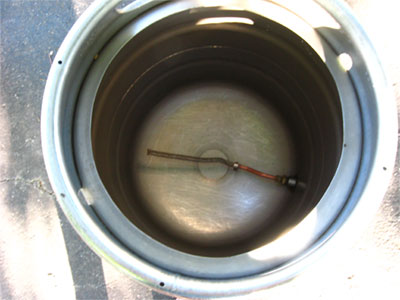
Monday night I brewed.
Oh, and I did the dishes, after a manner: I washed out the carboys I'd kegged things up from last week. I'd been out of PBW, Powdered Brewery Wash, which makes such short work of these things.

I'm only posting it now because it was midnight when I was done and ready to go to bed, and I was so exhausted Tuesday night from sleep deprivation, fatigue and so on that I didn't even finish cleaning up what I'd left from Monday (a brew kettle that would do just fine with another day soaking).
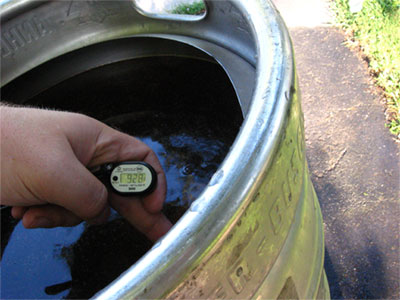
Then Wednesday it was Back to School shopping. A nightmare. Anyways, back to seizing the beer...
After refusing to do anything but all grain brews for practically ever, I finally did an extract batch. I've used a bit of extract to boost gravity on the occasional strong beer like Oud Grendel, a peat smoked Scotch ale I make from time to time. But generally, for me, brewing means mashing in.
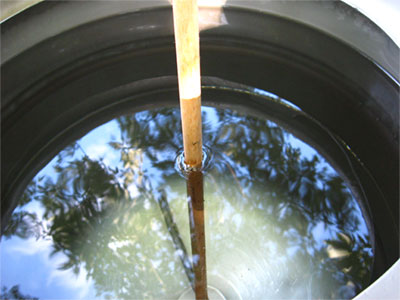
I made about a half dozen extract batches when I was starting out (in 1995). All grain brewing seemed dicey and difficult when I read about it. But then I met John Weerts (who's name is phonetically eponymous with beer while it's being boiled), and went to his house one Sunday. He and Chef Dan were brewing 10 gallons of all grain IPA in the driveway, 5 gallons of extract Hefeweizen in the kitchen, smoking bratwursts on the back deck and watching the Chief's game. Mainly, they were watching the Chief's game.
So I was like, Okay, these two honyocks aren't even paying attention and they can do this. Maybe I can, too.

One thing people seem to ask me about as much as anything when they find out I brew is do I like dark beer? Well, yeah, I do. I also love pale beer. Asking me if I like dark beers to the exclusion of pale is like asking me if I Faulkner to the exclusion of Steinbeck. It's adoring Liv Tyler to the exclusion of Scarlett Johansen instead of the honest answer that I want both to be my sex slaves.

But one of my favorite areas of beer are the pale ales. From ordinary bitters to Imperial IPAs, these are beers defined as much by their hops as anything. While many of them aren't 'bitter' in the way you might think, they are all beers with a pronounced hop presence.

Of course, we Lobsters raise such things to a fetish. But the whole idea of a 'pale' ale gets intriguing when you're brewing with extracts. The process of evaporating wort to the point where it can be canned or dried to powder is inevitably caramelizing. So a deep amber is about as light as most extract beers get. My first all grain batch was fascinating in part because it was the lightest colored brew I'd managed to date.
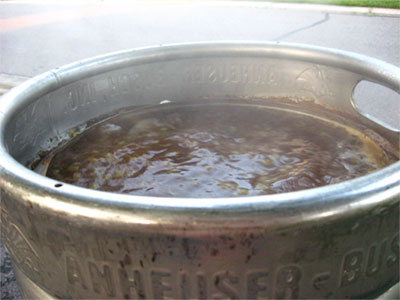
Still, I can make a relatively light-colored beer, maybe more amber than golden using extracts, and I can use hops with reckless abandon. And I did.
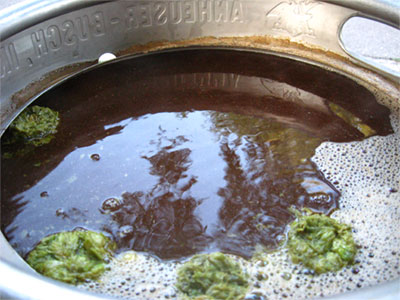
I loves me some bitter beer. I remember when Alimony Ale came out, billed as the 'bitterest beer in America,' I was so stoked. Then I got a bottle of it and I think they must have forgotten the hops. Or it was just a marketing slogan.
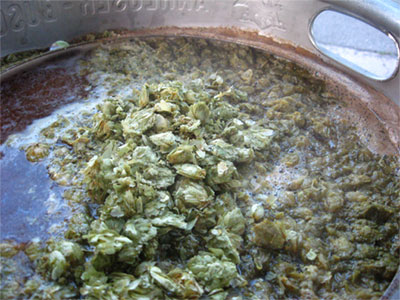
Bitterness in beer is measured in IBUs, International Bittering Units. To give you a frame of reference, Budweiser weighs in at 8.5 IBUs, and the typical human's threshold of perception is in the 10 IBU ballpark. Meaning Bud is not noticeably bittered to the average palate. If Bud seems bitter to you, you're exceptionally sensitive to bitterness. Guiness Extra Stout, on the other hand, is more like 65 IBUs.

Lobsterland Bitter that I brewed Monday: 96 IBUs. This is perfect because above 100 IBUs is physically all but impossible. The isomerization of alpha acids above that level just doesn't happen, so additional bittering hops won't provide more bitterness. What they'll provide is a grassy flavor if you keep adding them practically by the pound. Trust the voice of experience on this one.

Six hours after I got home and commenced to start brewing, I was cleaned up and put away. This is a good four hours faster than I'd ever get an all grain batch finished.

The malt extract comes in cans. You can also get a powdered version which is very much like Carnation Malted Milk. The syrup is about the consistency of honey, maybe a little lighter. I used four 4lb cans for this batch, yielding a specific gravity of 1.046. I aimed to make a slightly more substantial beer, but as I forgot how much evaporation I get on the all grain batch I made in April, this time I forgot how much volume that extract takes up and despite extra effort to evaporate as much as possible, my ten gallon batch finished up more like 12 gallons.
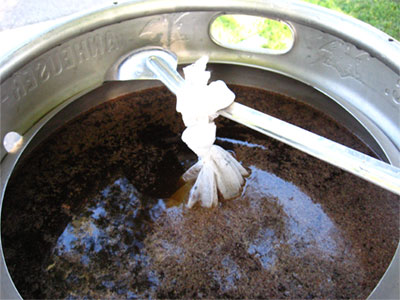
I did use some specialty grains to impart qualities not found in canned extract. In this case, a pound of 110º crystal malt and a pound of Golden Naked Oats. The latter are an oat that's been malted and partially converted, kilned and husked. I've never used it before, but it had a promising toasty/nutty flavor.

I used my mash tun to boil it so I could use my Easy Masher as a hop back.
By the way, these are leaf hops:

Hops are papery green flowers. They also come in pellets, which I don't use. The pellets look a bit like gerbil food, and the process of making them that way degrades the hops. It's not for purists. A middle ground, hop plugs, I love. The plug is leaf hops compressed to where there's no air to oxidize the alpha and beta acids that make the magic of hops. They keep very well, but without the drawbacks of pellets.

I used a couple of ounces of Warrior plugs in this batch, but it's getting hard to find hops in plug form. I don't know why the method has fallen out of favor with suppliers. A few years ago, you could get pretty much any hop in plugs, from Czech Saaz to German Hallertau to Idaho Cascade to East Kent Goldings.

Anyway, I ended up with about 12 gallons of wort with a specific gravity of 1.046. According to Rooftop Brew's calculator, I'm at 96 IBUs. It might not register as a 'light' beer to someone who drinks Lite beer, but it'll be relatively low in alcohol and you'll be able to see through it.

No comments:
Post a Comment